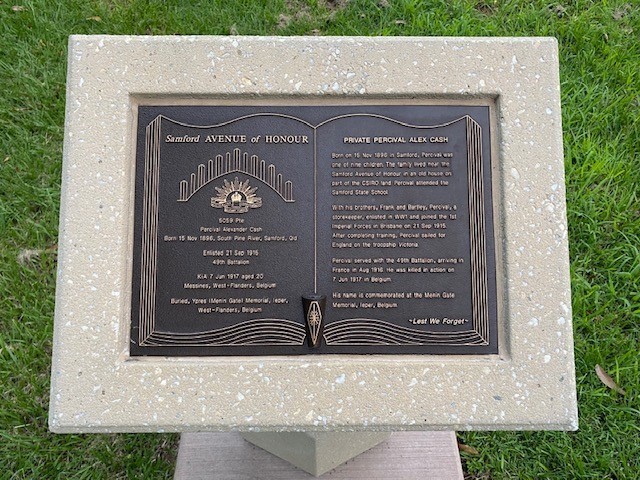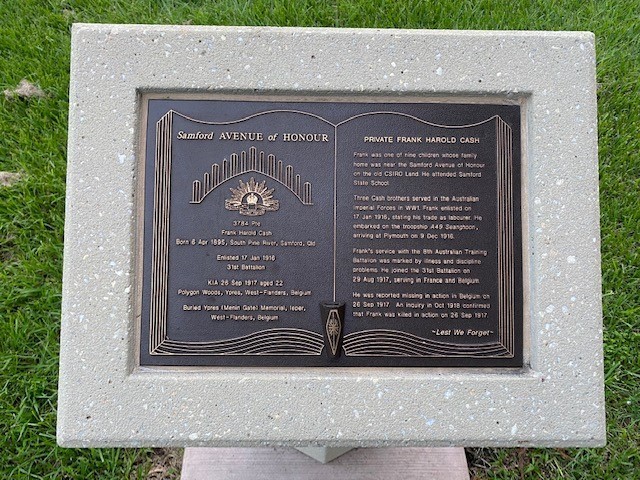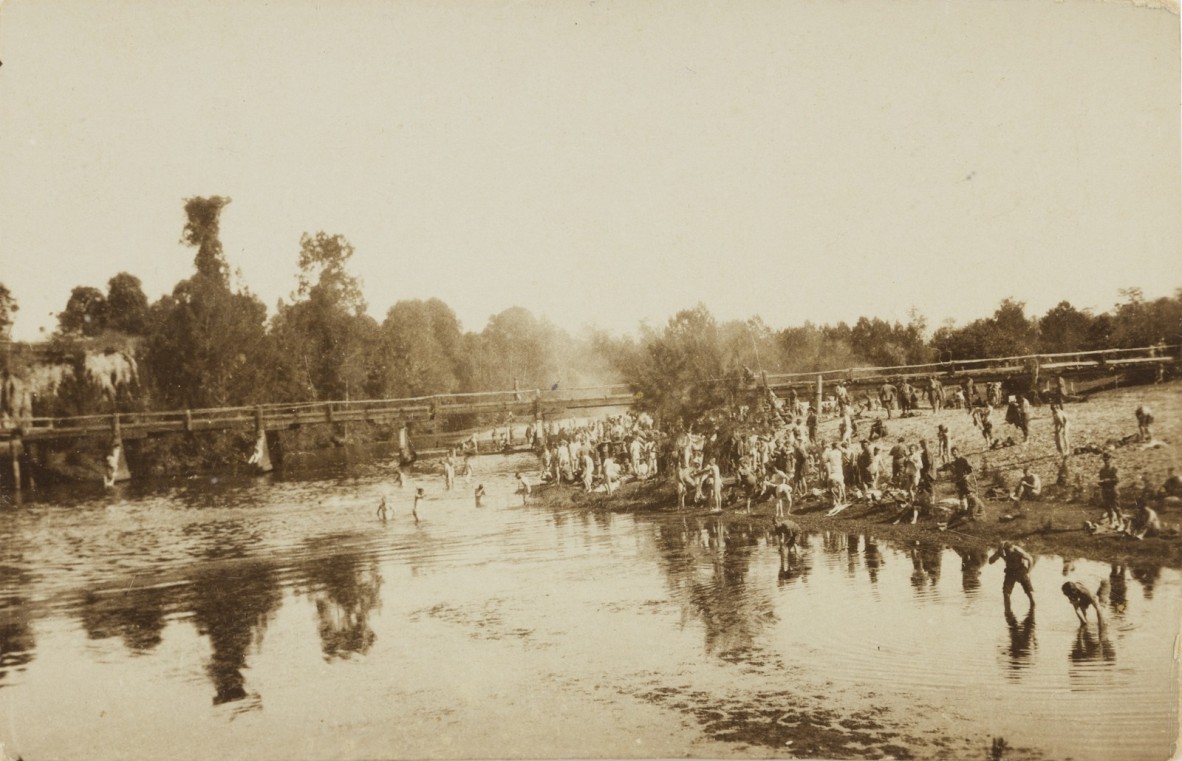The Cash Brothers - District Honours Local Family’s WWI Service
By Pauline Gordon, Visitor Services Assistant - Anzac Square Memorial Galleries | 16 April 2021
In the suburbs north west of Brisbane lies Samford Village. Now a part of the Moreton Shire Council region, the area was previously known as Pine Rivers. From 1824 to 1838 Brisbane operated as a penal colony. Once the penal colony closed, free settlers interested in opening up farming leases began to investigate areas both north and south of the Brisbane River. This was a period in our nation’s history when the government and European immigrants did not recognise any Aboriginal ownership or connection to the land so it was all considered Crown Land and negotiations were only made with the local government.
In the area now known as Samford and Eatons Hill, James Cash was the first free settler to occupy and eventually buy a portion of land, totalling 86 acres, on the banks of the South Pine River in 1859. He built a modest home, farmed and raised his family there. The Cash family were well known for the hospitality they extended to people travelling through the region to lands further north.
Successive generations were active in the community in this region for well over 100 years, continuing with the generous example set by their forbears. Land for the Farmers Hall and sporting fields in the centre of what is now Samford Village was donated by Cash family members.
John and Bridgett Cash raised their family of 9 children on land that was later used by CSIRO for pasture research. The First World War saw 4 of John and Bridgett’s sons sign up to serve. Two signed up in September 1915 and the other two in January 1916.
Percival (Percy) Alexander Cash, serial no. 5059, enlisted in Rockhampton 21st September 1915. He was the youngest of the 4 brothers to serve at only 19 years old. After basic training he embarked on the “Victoria” sailing for Egypt, completed further training and then went on to France and England, where he learned a hard lesson about Army discipline. He was charged with using obscene language to a non-commissioned officer and forfeited 7 days pay as a penalty.
Percy served with the 49th Battalion AIF and spent two months attached to the Miners Corps. Percy was killed in action on 16th June 1917 in Belgium. He has no known grave and is listed on the Menin Gate Memorial in Ypres, Belgium.

Percy’s plaque on the Avenue of Honour in Samford. Photo by SLQ staff member Pauline Gordon.
Frank Harold Cash, serial no.3784A, enlisted in Brisbane on 17th January 1916 at 21 years of age. On his voyage to England he was charged twice with being Absent Without Leave when he failed to attend parade on the ship. Each time he was penalised a full day’s pay for his lack of military discipline. Frank’s relatively short military career involved several stints in hospital with sicknesses and injuries before he was eventually killed in action in the vicinity of Polygon Wood in Belgium while serving with the 31st Battalion AIF. He too has no known grave and is listed on the Menin Gate memorial in Ypres, Belgium.

Frank’s plaque on the Avenue of Honour, Samford. Photo by SLQ staff member Pauline Gordon.
A third brother, Frederick Joseph Cash, serial no.6583, enlisted the day after Percy, in Rockhampton on the 22nd September 1915. He was 23 years old. He was part of the 4th reinforcement of the 6th Field Company Engineers. He too endured several admissions to hospital with various illnesses as was common in World War I. Frederick received gunshot wounds to his left thigh and left arm on 20th May 1918. The bullet wound to his thigh went straight through and after treatment healed well. The bullet wound to his arm, however, damaged the nerves and muscles of his wrist. This left him paralysis of two of his fingers and loss of sensation to his hand and fingers requiring additional surgery. He was ultimately discharged as medically unfit for further service and returned home to his family in January 1919.
The fourth member of the family to enlist was Bartley William Cash but he apparently had a change of heart. His records show he enlisted and then failed to report to camp the same day. A warrant was issued for him to be apprehended and conveyed to Victoria Barracks in Brisbane. His Military records do not show if this warrant was acted upon.
The cash family is well respected in the Samford region with several landmarks named after them. Cash’s Crossing is the location of the shallow crossing of the South Pine River on the original property owned by James Cash.

Robert Cyril Palmer Brett; Members of the 25th Infantry Battalion swimming in the South Pine River, Cash’s Crossing, Brisbane, Queensland 1915: Brett and Burley Family Records, John Oxley Library, State Library of Queensland, Image no.M946-0078-0022
Pte Percy Cash Bridge sits just outside Samford Village, as does Private Frank Harold Cash Reserve. This reserve features a large boulder with bronze plaques telling the story of the military service of Frank and Percy.
The railings for Pte Percy Cash Bridge can be seen behind the sign for Private Frank Harold Cash Reserve. The large boulder holds the bronze plaques detailing the service of the two brothers lost in WWI and the Australian Imperial Force Insignia. Photos by SLQ staff member Pauline Gordon.
Cash Avenue is located in the centre of the village and both the Cash brothers lost in the First World War feature on plaques on Samford’s picturesque Avenue of Honour and at the Samford RSL.
The Cash family is only one of many Queensland families with more than one member who served during the first World War. Some families were devastated by enormous loss and others like the McComb family had five members serve and all returned home at war’s end. You can find out more about them and other Queenslanders who served by visiting the State Library of Queensland’s website and using the One Search function.
You can also read another State Library of Queensland blog about the men in the Dearden family and their war service here:
Comments
Your email address will not be published.
We welcome relevant, respectful comments.